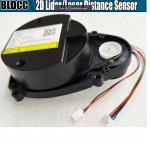Very impressive, but it will be tricky to interface to a Picaxe.
By default, it outputs a continuous stream of data at a stonking 230400 baud !.
A hardware serial port on the Picaxe could conceivably run at this speed, but I don't think the code could keep up.
The laser spins at 8 rpm. It is possible to slow this down, which might allow a Picaxe to keep up. Another method is to read the serial data at whatever speed you can, until a valid packet is seen. This random method misses out lots of data, but as it's updated 8 times a second you should eventually get the full picture.
Assuming we can get sensible angle and distance readings, what can we do with them ?
The distance and direction results are all relative to the the orientation of the sensor, which would allow a robot to easily see what is currently 'in front' or 'at the side' etc. Combining these with the robot's motion to provide a map would be a big challenge, and an even bigger challenge would be interrogating the map to let the robot determine it's location. It looks like building a SLAM is probably beyond the Picaxe envelope, but a simple object avoidance system looks possible.
As an example, if the full 360' is split into 8 directions ( N,NW,W,SW,S,SE,E,NE) each with a distance, then it would be easy to know which way the robot needs to move.
The above discussion assumes the robot needs to avoid any obstacle it can see, but if we adjust the calibration of the laser, and have fixed-location retro-reflective markers then it might be possible to build a crude SLAM. Lots of trigonometry calculations, and a big chunk of RAM, but it might work.
It's an interesting device at a price that won't break the bank.

